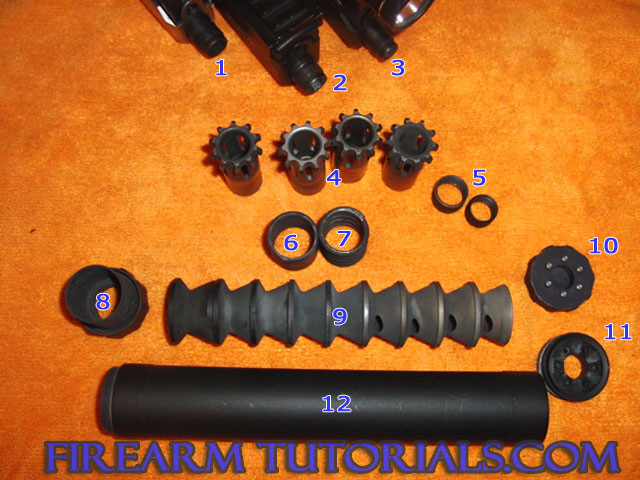Inside the AAC Tirant

- Suppressor host: HK USP Compact
- Suppressor host: HK Mark 23
- Suppressor host: HK USP SD
- Pistons in different thread pitches
- Barrel thread protectors
- Fixed barrel spacer
- Piston recoil booster
- Piston housing
- Baffle stack (aluminum)
- End cap removal tool
- End cap
- Suppressor tube (serialized part)
The 3 pistols shown are .45 and 9mm. Yes, you can shoot sub-calibers through a larger caliber suppressor. The pistons shown are for various barrel types. Mostly metric since the guns I primarily shoot are German. The thread protectors shown are not used much as the barrels in these guns are hardened after they are threaded. This makes the threads so hard the use of a thread protector is merely cosmetic.
The fixed barrel spacer is used for any gun that does not have a slide which cycles when fired. Examples would be the HK UMP, Ruger 22/45, or any bolt action rifle. The use of a piston recoil booster is necessary in all guns with a moving slide as it produces the extra pressure needed to cycle rounds.
The use of a recoil booster on a gun which does not require it puts unnecessary stress on the barrel threads. Over time, they may become stripped due to the extra tension provided by the recoil booster. The opposite is also true. If you use a fixed barrel spacer on a gun that requires a booster, the gun may not cycle properly. Usually it produces malfunctions like failure to eject, stovepipes, or feeding errors.
The piston housing is made from stainless steel and holds both the piston and booster/barrel spacer. It is the heaviest part of the suppressor and also gets dirty very quickly.
The baffle stack is made from aluminum, except for the first baffle which is stainless steel. The first baffle commonly called the "blast baffle" as it takes the most abuse and is first in line when the bullet comes down the barrel. It gets considerably dirty and requires are good amount of scrubbing to come clean. Each baffle has a port as seen in the last 4 baffles of the stack. The first 5 have ports which are not seen in the photo because they are turned 90 degrees from the front-most ones to aid sound suppression.
The end cap must be removed with the AAC provided end cap removal tool. DO NOT try to open it with anything else as you will probably strip out or break the end cap.
The last part is the actual tube which is made from titanium. It should be wiped out as it does accumulate carbon from the baffle ports. It is the only part of the suppressor which contains the serial number.
Overall the Tirant 45 is a great choice. It can be shot wet or dry. Unlike some others it is hearing safe even when DRY. In addition to the sound suppression, the flash suppression is also second to none. I used this setup at a night shoot and the flash signature was completely hidden.
The downside... price. It retails for around $850. Not to mention the 5+ months to wait for the ATF to approve it and $200 more for the tax stamp. If you are in the market for a .45 suppressor you cannot go wrong with the Tirant. Here is a recap with some footage of me opening the Tirant to expose the baffles:
4 comments
Would you get a Tirant or get a SWR octane HD
I can not make up my mind

Octane 45 HD for sure. It’s cheaper and has a better baffle design.
I have a youtube video that shows me cleaning the Tirant baffles with dremel.
The same cleaning process is much easier on the Warlock which has the same baffle design as the Octane.
BTW, I called the ATF yesterday to check on my transfer and the said the wait time is 9 months now!!!
So much for getting my Octane 9 HD before Christmas!
God, I just ordered my Tirant for my HK. By this I guess next March may be when I get mine. Hope I live long enough to check it out. I will save this site so when I do get it, I can relate as to how to clean it. I am acquiring mine thru a trust though.

LOL. I was thinking the same thing. I almost said the lady on the other end of the phone “9 months! I’ll be dead by then!” The Tirant is still a great can. I used a trust as well. Here is how I clean the baffles:
 10/07/12 05:42:00 pm,
10/07/12 05:42:00 pm,